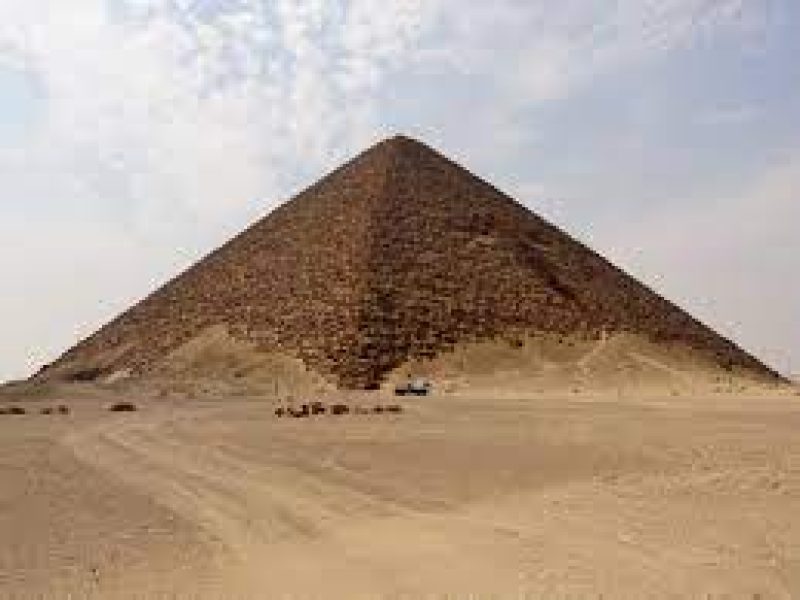The Red Pyramid, also called the North Pyramid, is the largest of the pyramids at the Dahshur necropolis in Cairo, Egypt. Named for the rusty reddish hue of its red limestone stones, it is also the third largest Egyptian pyramid, after those of Khufu and Khafre at Giza. It is Egypt’s first successful attempt at constructing a “true” smooth-sided pyramid. Local residents refer to the Red Pyramid as el-heram el-watwaat, meaning the Bat pyramid .

Origin of the name
The pyramid got its name out of the reddish casing of lime stone but unfortunately nothing remains of it but traces. stadermann claims that there were some inscriptions. The four sides of the pyramids are facing accurately the four cardinals of the world.
The Red Pyramid was not always red. Engineers who built it cased it with white, but only a few of these stones now remain
During the Middle Ages Egyptians took much of the white Tura limestone for buildings , revealing the red limestone beneath
History of the red pyramid
Old Kingdom Pharaoh Sneferu built the Red Pyramid 2575–2551 BC, it was his third pyramid , The Red Pyramid is located approximately one kilometer to the north of the Bent Pyramid.
Egyptologists disagree on the length of time it took to construct. Based on quarry marks found at various phases of construction, Rainer Stadelmann estimates the time of completion to be approximately 17 years while Rolf Krauss, based on this same graffiti, suggests a period of construction of 10–11 years, an estimate later supported by John Romer.
Archaeologists speculate its design may be an outcome of engineering crises experienced during the construction of Sneferu‘s two earlier pyramids. The first of these, the Pyramid at Meidum, collapsed in antiquity, while the second, the Bent Pyramid, had the angle of its inclination dramatically altered from 54 to 43 degrees part-way through construction.
Some archaeologists now believe that the Medium pyramid was the first attempt at building a smooth-sided pyramid. It may have collapsed as evident by the presence of large timber beams supporting its inner chambers.
The outcome of this was the change in inclination of the Bent Pyramid, and therefore less susceptible to catastrophic collapse.
Architecture of the pyramid
The Red Pyramid is 105 metres (344 ft) high, and 220 metres (720 ft) wide. A rare pyramidion for the Red Pyramid has been reconstructed , as its angle of inclination differs from that of the pyramid .
The inner structure of the pyramid consists of an entrance at the north side. The entrance is connected to a descending passage which leads to a corridor about 62 m height. After finishing the corridor there are two identical rooms (antechambers) the second one (next to the burial chamber) is exactly under the apex of the pyramid and it is considered the entrance of the burial chamber because it is connected to it. All the chambers have corbelled roof with a design which decreases the pressure of the pyramid over them. The pyramid had a cap stone on the top but it fell.
Visitors climb steps cut in over the stones of the pyramid to an entrance on the north side. A passage, 3 feet (0.91 m) in height and 4 feet wide. It slopes down at 27° for 200 feet to passage leading into a chamber whose roof is 40 feet high. At the southern end of the chamber another horizontal passage leads into the second chamber.




Comment (0)